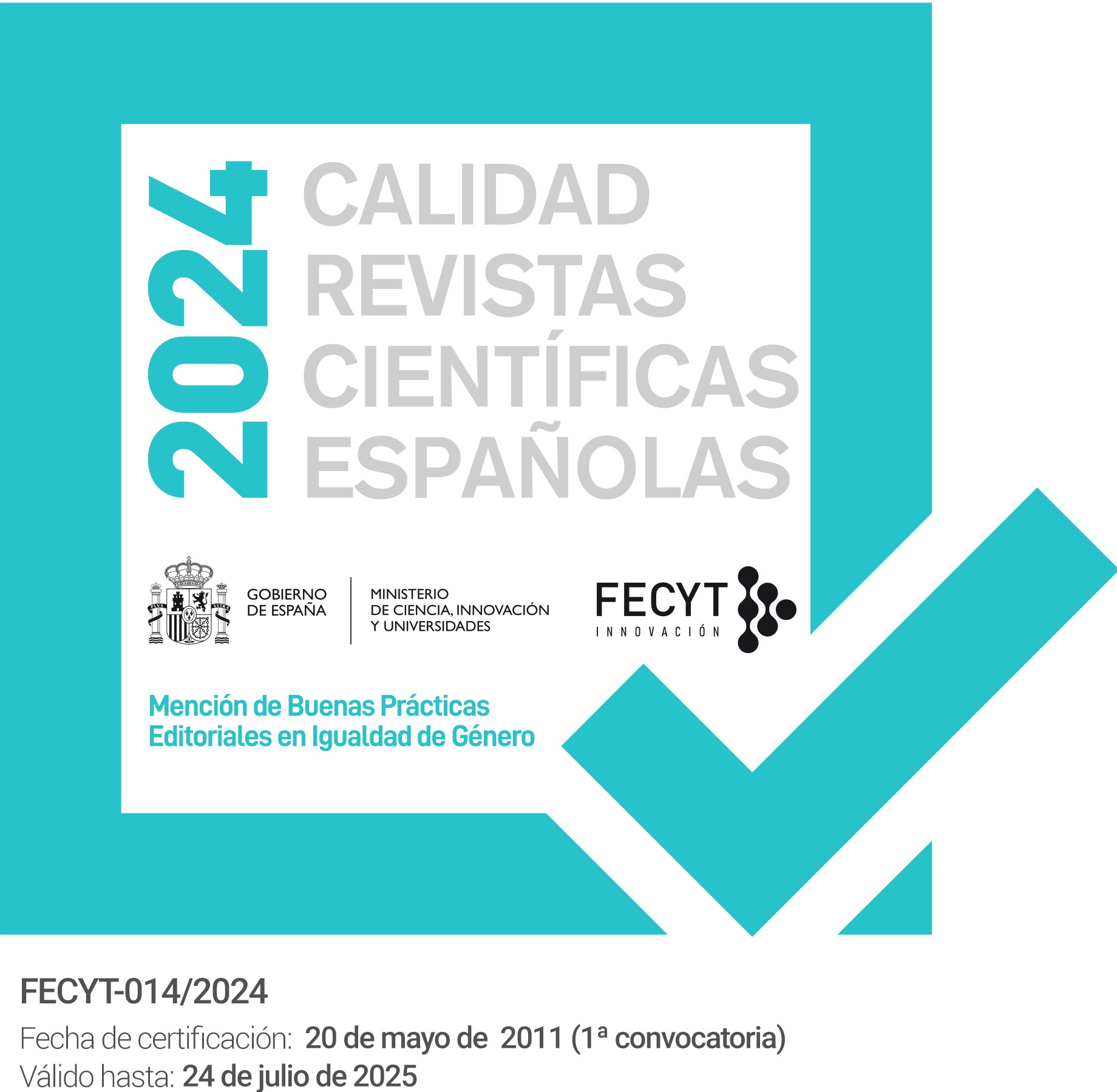El estudio de las migraciones internacionales desde una perspectiva del género
Resumen
Constituye este artículo un análisis crítico de los diferentes modelos teóricos aplicados al estudio de las migraciones desde la perspectiva de la Antropología del género.
Descargas
Referencias
AMIN, Samir: El desarrollo desigual, Barcelona, Fontanella, 1974.
ANTHIAS, Floya: Etnicity, class, gender and Migration, England,Avebury, 1992.
ARIZPE, Lourdes:Migración por relevos y la reproducción social delcampesinado,México, El Colegio de México, CES, 1980.
ARNOLD, Fred, & PIAMPITI, Suwanlee: Female Migration in Thai-land,en FAWCETT, J. T.; KHOO, S. E., & SMITH, P. C., 1984.
BACH, Robert L., & SCHRAML, Lisa A.: «Migration, Crisis and The-oretical Conflict», International Migration Review, 16 (2),1981, 320-341.
BÁEZ EVERTSZ, Francisco: «Migración internacional dominicana y política de migración: viejos enfoques y nuevas tendencias»,Síntesis, 17, mayo-agosto, 47-61, 1992.
BARNES, John Arundel: «Class and committes in a Norwegian island parish», Human Relations,7 (1), 1954, 39-58.
BAUDIN, T.; COLLIN, H., & GUILLEM, D.: «Women and Immigrants:marginal workers?», en CROUNC, &
PIZZORNO, A. (eds.), The Re-surgence of Class Conflict in Westers Europe Since 1968. Comparative Analysis,vol. 2, London, The Macmillan Press, 1978.
BASCH, Linda; GLICK-SCHILLER, Nina, & SZANTONBLANC, Cristina:Nations Unbound. Transnational Projects, Postcolonial Predi-caments and Deterritorialized Nation-States, Usa, Gordon and Breach Science Publishers, 1994.
BENERIA, Lourdes (ed.): Women and Development: Sexual Divi-sion ol Labor in Rural Societies, New York, Praeger, 1982.
BOSERUP, Esther: Woman’s Role in Economic Development, London, George Allen and Unwin, 1970.
BOTT, Elizabeth:Family and social network, London, Tavistock Institute of Human Relation, Edición en castellano: 1990.
Familia y red social, Madrid, Taurus humanidades, 1971.
BRETTELL, Caroline B., and SIMON, Rita J.: «Immigrant Women:An Introduction», en SIMON, Rita J. & BRETTELL Caroline B.(eds.), 1986, International Migration.
The Female Experience,New Jersey, Rowman & Allanheld, 1986.
BRITTAN, A., & MAYNARD, M.: Sexism, Racism, and Oppression, Oxford, U.K., Basil-Blackwell, 1984.
BRYCE-LAPORTE, Roy S.: The New Immigration: The Female Majo-rity,en Mortimer, Delores M., & Bryce-Laporte, Roy S. (eds.)1981.
BRYCESON, Deborah: «Women’s proletarianisation and the familywage in Tanzania», en AFSHAR, Haleh (ed.), Women, Work andideology in the Third World, London, Tavistock, 1985.
BRYDON, Lynne & CHANT, Sylvia: Women in the Third World: Gen-der Issues in Rural and Urban, England, Edward Elgar, 1989.
CASTELLS, Manuel: «Immigrant Workers and Class Struggles inAdvanced Capitalis: The Western European Experience», Po-litics and Society, 5 (1), 1975, 33-66.
GEORGES, E.: The Making of a Transnational Community. Migration, Development, and Cultural Change in the Dominican Republic, New York, Colombia University Press, 1990.
GLENN, Evelyn Nakano: «Racial, Ethnic Women’s Labor the in-tersection of Race, Gender and Class Oppression», en BLUMBERG, Rae Lesser (ed.): Gender, Family, and Economy. The triple Overlap, U.K., Sage publications, 1991.
GRASMUCK, Sherri & PESSAR, Patricia: Between Two Islands. Dominican Internacional Migration, California, University of Ca-lifornia Press, 1991.
GREGORIO GIL, Carmen: «El grupo inmigrante y su proyecto mi-gratorio: aspectos psicosociales, culturales y de género», Intervención Psicosocial,3 (7), 1994, 75-90.
GREGORIO GIL, C.: Sistemas de género y migración internacional: la emigración dominicana a la Comunidad de Madrid, Dpto. Sociología y Antropología social, Universidad Autónoma de Madrid (Tesis doctoral), 1996.
GONZÁLEZ, Nancie L.: «Peasants Progress: Dominicans in NewYork», Caribbean Studies, 10, 1970, 154-171.
GONZÁLEZ, Nancie L.: «Multiple Migratory Experiences of Domi-nican Women», Anthropological Quarterly, 49 (1), 36-43,1976.
GURAK, Douglas T., y KRITZ, Mari M. (1987): «Los patrones de mi-gración de los dominicanos y de los colombianos en la ciudadde New York: el rol de las redes de parentesco», en CASTILLO,Jose del, y MITCHEL,
Christopher (eds.) (1987), La inmigracióndominicana en los EE.UU., Santo Domingo, Cenapec. HARRIS, Olivia, y YOUNG, Kate (eds.): Antropología y feminismo,Barcelona, Anagrama, 1979.
HARTMANN, Heidi (1976): «Capitalismo, patriarchy and job segre-gation by sex», en BLAXALL, M., & REAGAN, B. (eds.) (1976),Women and the Workplace the Implications of Ocupational Segregation, Chicago, University of Chicago Press, 1981.
HENDRICKS, Glenn:The Dominican Diaspora: From the DominicanRepublic to New York City, Villagers in Transition, New York,Teachers College Press, Columbia University, 1974 (ediciónen castellano, Los dominicanos Ausentes. Un Pueblo en Transición, Santo Domingo, Alfa y Omega, 1978).
HEYZER, Noeleen: «Towards a Framework of Analysis», BulletinInstitute Of Development Studies, Sussex, 12 (3), 3-7, 1981.
HEYZER, N. (1982): «From rural subsistence to an industrial pe-ripheral work force: An examination of female malaysian mi-grants and capital acumulation in Singapore», en BENERÍA,Lourdes. (ed.) (1982), Women and Development: Sexual Division ol Labor in Rural Societies, New York, Praeger. INSTRAW: The Migration of Women. Methodological Issues in theMeasurement and Analysis of Internal and International Migration, Santo Domingo, Instraw, 1994.
IZZARD, Wendy: «Migrants and mothers: case-studies from Bots-wana», Journal of Southern African Studies2 (2), 1985, 258-80.
JELIN, Elizabeth: «Migration an Labor Force Participation of La-tin American Women: The Domestic Servants in the Cities»,Sings3 (1), 1977, 129-141.
JELIN, E. (1991): «Family and Household: outside world and Pri-vate Life», en JELIN, E. (ed.) (1991), Family, household andgender relations in Latin America, London, Kegan Paul Inter-nacional Unesco.
KABEER, Naila (1985): «Do Women Gain from High Fertility?»,en AFSHAR, Haleh. (ed.) (1985), Women, Work and ideology inthe Third World, London, Tavistock.
KEARNEY, Michael: «From the invisible hand to the visible feet anthropology studies on migration and development»,An-nual Review of Anthropology, 15, 1986, 331-361.
LEACOCK, Eleanor: «Women’s status in egalitarian society: impli-cations for social evolucion», Current Anthropology,19 (2),1978, 247-75.
LEEDS, Anthony: «Women in the migratory process: a reductio-nist outlook», Anthropological Quaterly,49, 1976, 69-76.
LITTLE, Kenneth: African women in towns an aspect of african’ssocial revolution. Cambridge, University Press, 1973.
LOMNITZ, Larissa A.: Cómo sobreviven los marginados, México, Siglo XXI, 1975.
LOMNITZ, L. A., & PÉREZ-LIZAUR, Marisol (1991): Dynastic Growthand Survival Strategies: the Solidariry of Mexican Grand-families,en JELIN, Elizabeth (ed.), 1991.
MASSEY, Douglas et al.: Return to Aztlan: The Social Process of International Migration from Western Mexico,Berkeley, Univer-sity of California Press, 1987.
MEILLASSOUX, Claude:Maidens, Meal and Money, London, Cam-bridge University Press. (Edición en castellano, Mujeres, graneros y capitales, Madrid, Siglo XXI), 1975.
MITCHELL, J. C. (ed.):Social Networks in Urban Situations, Man-chester, Manchester University, 1969.MOORE, Henrietta L.: Antropología y feminismo, Madrid, Cátedra,1991.
MOROKVASIC, M. (1983): Women in Migration: Beyond the reductionist outlook,en PHIZACKLEA, M. (ed.), 1983.
MOROKVASIC, M.: «Bird of Passage are also Women», International Migration Review, vol. 18 (4), 1984, 886-907.
MOROKVASIC, M.: «¿Por qué emigra la mujer?», El País, Extra, Lasnuevas «invasiones», año V, núm. 188 (20 junio), 8-9, 1991.
MORTIMER, Delores, M., & BRYCE-LAPORTE, Roy S. (eds.): Female Immigrants to the United States: Caribbean, Latin American,and African Experiences, RIIES Occasional Papers núm. 2,Washington, D.C., 1981.
NASH, June & FERNÁNDEZ-KELLY, M.ª Patricia (eds.): Women, Men,and the International Division of Labor, Albany, State Univer-sity of New York Press, 1983.
NASH, June & SAFA, Helen. I. (eds.): Sex and clase in Latin Ameri-ca,Bergin Publishers, New York, 1980.
OLIVEIRA, Orlandina (1991): «Migration of Women, Family Orga-nization and Labour Markets in Mexico», en JELIN, Elizabeth(ed.) 1991.
ONG, Aihwa: «Los sistemas de género en el Sudeste de Asia», IsisInternacional,16, 1992, 109-122.
ORTNER, Sherry (1979): «¿Es la naturaleza con respecto al hom-bre lo que la naturaleza con respecto a la cultura?», en HARRIS, Olivia & YOUNG, Kate (eds), 1979.
PESSAR, Patricia: «The Role of household in International Migra-tion and the case of U.S.- Bound Migration from the Domini-can Republic», International Migration Review,16 (2), 1982,342-364.
PESSAR, P.: «The linkage between the Household and Workplaceof dominican Women in the U.S.», International MigrationReview,18 (4), 1984, 1188-1210.
SASSEN-KOOB, S. (1983), Labor Migration and the New IndustrialDivision Labor,en NASH, June & FERNÁNDEZ-KELLY, M.ª Patri-cia (eds.) 1983.
SASSEN-KOOB, S.: «Notes on the Incorporation of Thrid WorldWomen into Wage-Labor Through Immigration and Off-Sho-re Production», International Migration Review, 18 (4), 1984,1144-1167.
SASSEN-KOOB, S. (1988): The mobility of labor and capital:a studyin international investment and labor flow, Cambridge University Press. (Traducción al castellano (1993), La movilidaddel trabajo y del capital. Un estudio sobre la corriente internacional de la inversión y del trabajo,Madrid, Ministerio de Trabajo y Seguridad Social, colec. Informes y estudios serie empleo, núm. 1).STIER, Haya & TIENDA, Marta: «Family, Work and Women: The Labor Supply of Hispanic Immigrant Wives», International Migration Review, 26 (4), 1992, 1291-1313.
STRATHERN, Marilyn (1979): Una perspectiva antropológica,en HARRIS, Olivia and YOUNG, Kate (eds.), 1979.
STRAUCH, Judith (1984): Women in rural Urban Circulation Net-works: Implications for Social Structural Change,en FAWCETT,James T.; KHOO, Siew Ean & SMITH, Peter C., 1984.
SUTTON, C. R. (1992): «Some Thoughts on Gendering and Inter-nationalizing Our Thinking about Transnational Migrations»,en SCHILLER, Nina G.; BASCH, Linday & BLANC-SZANTON,C.S.(eds.) (1992), Towards A Transnational Perspective on Migra-tion,New York, The New York Academy of Sciences.
THADANI, V., & TODARO, M. (1984): Female Migration: A Conceptual Framework,en FAWCETT, James T.; KHOO, Siew-Ean & SMITH,Peter C., 1984.
TRAGER, Lilian: «Family Strategies and the Migration of Women:Migrants to Dagupan City, Philippines», International Migration Review, 18 (4), 1984, 1264-1277.
WALLERSTEIN, Immanuel and SMITH, Joan (1991): «Households asan Institution of the World-Economy, en BLUMBERG, Rae Les-ser (ed.) (1991),
Gender, Family, and Economy. The triple Overlap, U.K., Sage publications. WESTWOOD, Sallie & BHACHU, Parminder (eds.):Enterprising Women. Etnicity, Economy, and Gender Relations, London, Rou-tledge, 1988.
WOOD, Charles H.: «Structural Change and Household Strategies: A Conceptual Framework for the Study of Rural Migra-tion», Human Organization, 40 (4), 1981, 338-343.
WOOD, Charles H.: «Equilibrium and Historical-Structural Pers-pectives on Migration», International Migration Review,16 (2), 1982, 298-319.
YOUNG, Kate (1979): Modos de apropiación y trabajo femenino:Oaxaca, México,en HARRIS, Olivia and YOUNG, Kate (eds.),1979.YOUNG, Kate (1982): «The Creation of a relative surplus popula-tion: A case study from Mexico», en BENERÍA, Lourdes (ed.)(1982), Women and Development: Sexual Division ol Labor inRural Societies, New York, Praeger.
Descargas
Número
Sección
Licencia
Los autores de artículos aceptados en la revista Migraciones conservan los derechos de propiedad intelectual sobre sus trabajos y otorgan a la revista los permisos de distribución y comunicación pública de los mismos, consintiendo que se publiquen bajo una licencia Creative Commons NonCommercial-NoDerivatives-Attribution 4.0 International License. Se recomienda a los autores publicar su trabajo en Internet (por ejemplo en páginas institucionales o personales, repositorios, etc.) respetando las condiciones de esta licencia y citando debidamente la fuente original.






